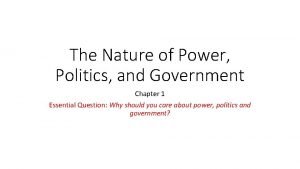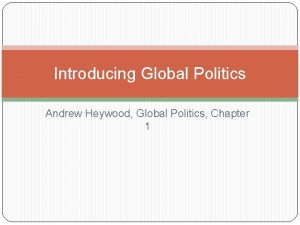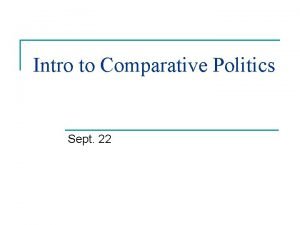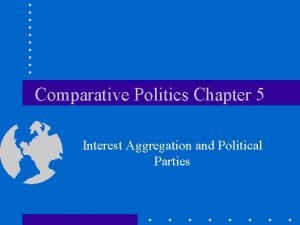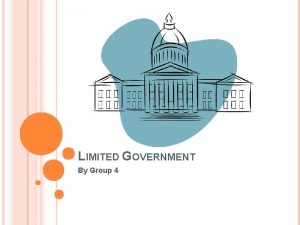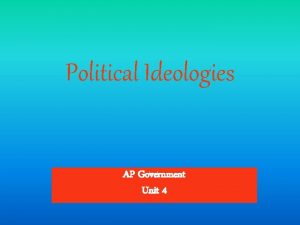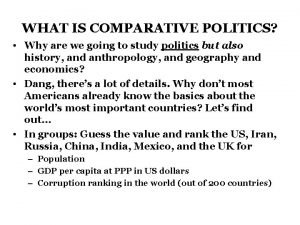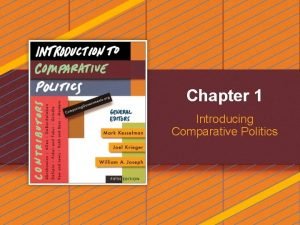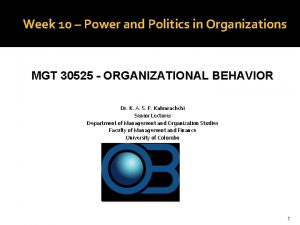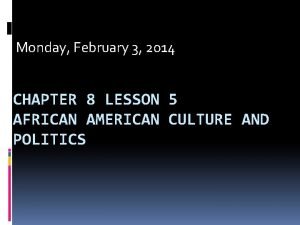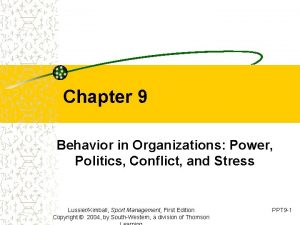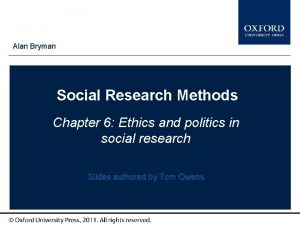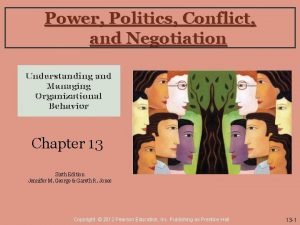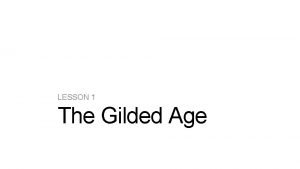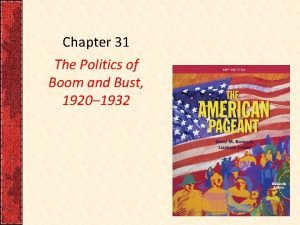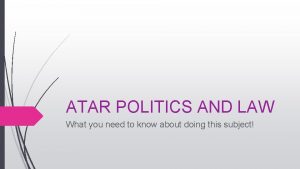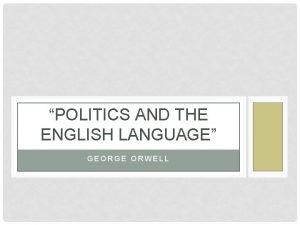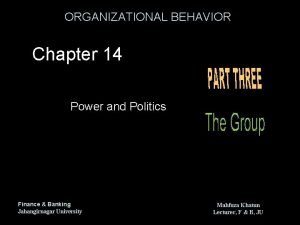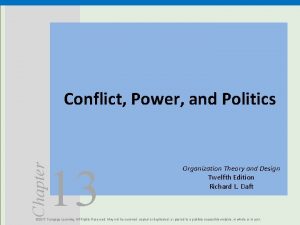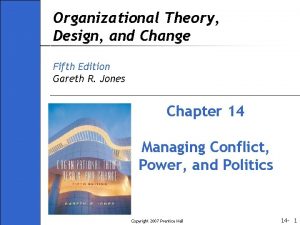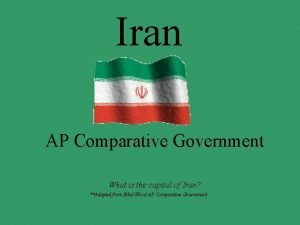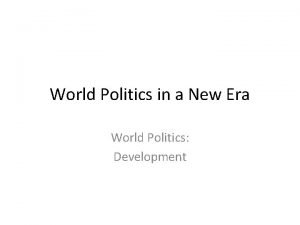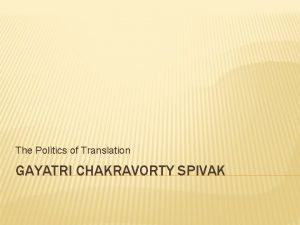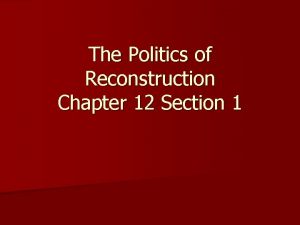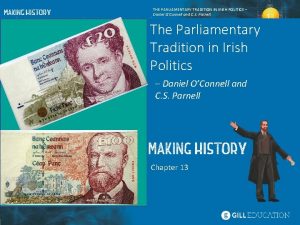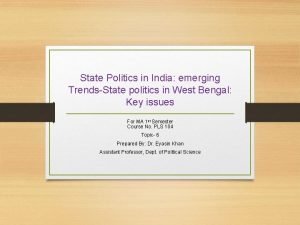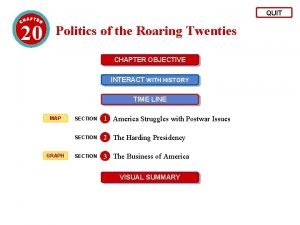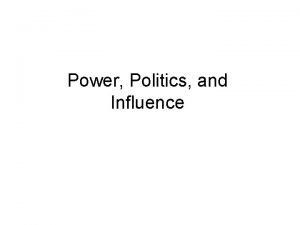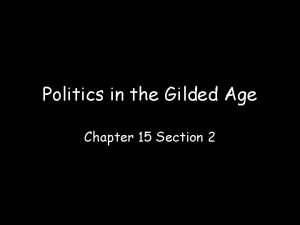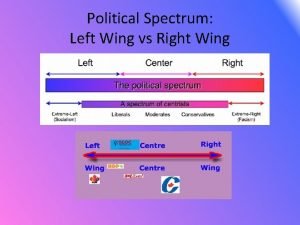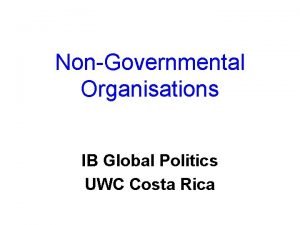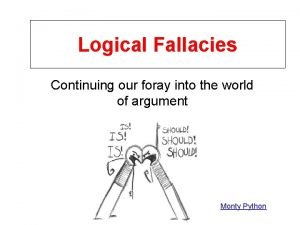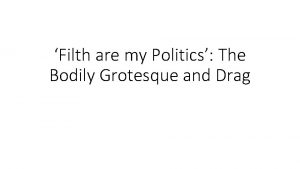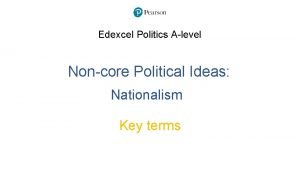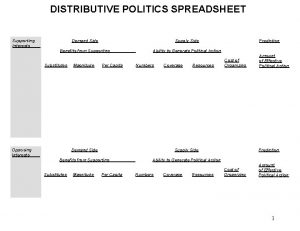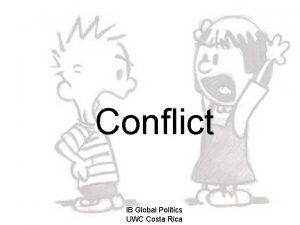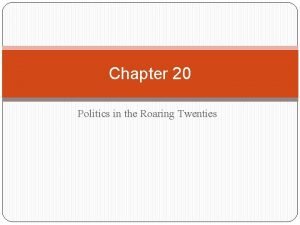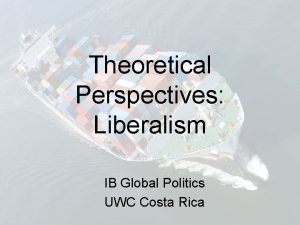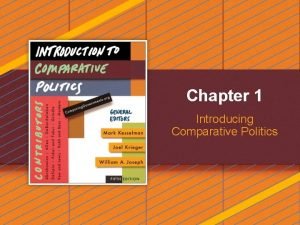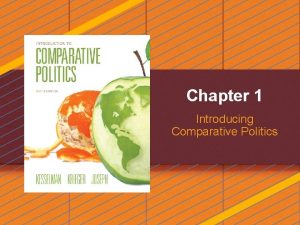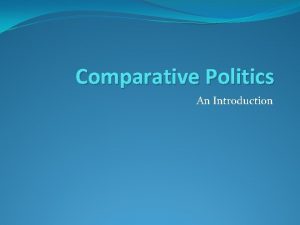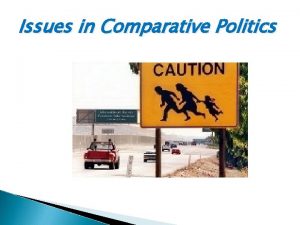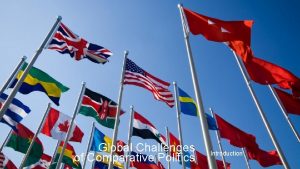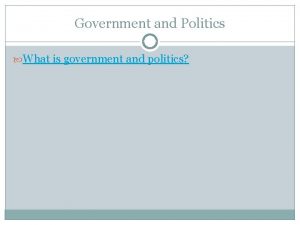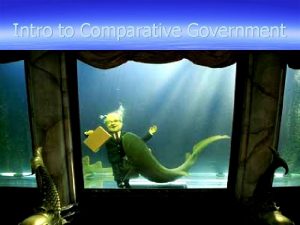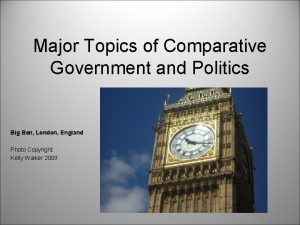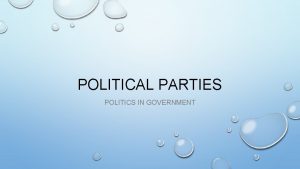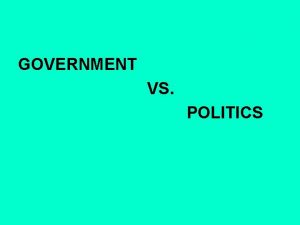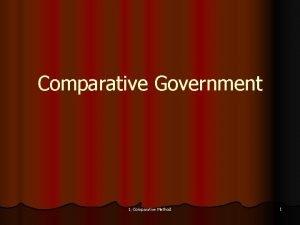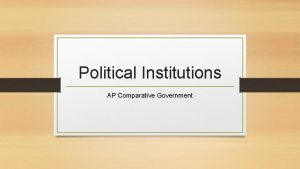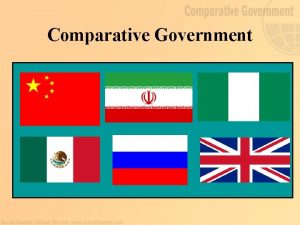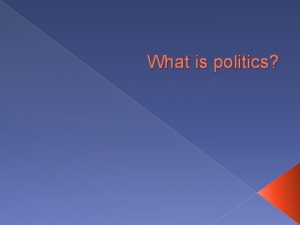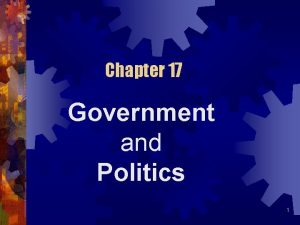Comparative Political Literacy Comparative Government and Politics Topics


























































- Slides: 58

Comparative Political Literacy Comparative Government and Politics

Topics of Comparative Government The Comparative Method Sovereignty, Authority, and Power Political and Economic Change Citizens, Society, and the State Political Institutions Public Policy

Government vs. Politics Government- Leadership and Institutions that make policy decisions for a country. Politics-Who has the power to make decisions and how did they get it?

The Comparative Method Empirical Data- Based on factual statements and statistics. Scientific Method- Hypothesis, testing variables and judging correlations. “Three-world Approach”- Based in Cold War Politics. 1 st world-US and allies 2 nd world- Soviet Union and its allies 3 rd world- Nations not in first two categories that were economically deprived. How is this a problem?

The Comparative Method 3 New Groupings Liberal Democracies Like “first world””Developed World” Global Influence via restrictive group membership High Quality of Life Indicators Democratic Regimes Respect of Individual Rights and Properties Japan, US, Canada

The Comparative Method 3 New Groupings Communist/Post- Communist States Making transition from command economy (state planned) to market economy (consumer driven) Parties with a watchdog role Czech Republic, Hungary, Poland (“emerging stars”

The Comparative Method 3 New Groupings Less Developed and Newly Industrializing Less Developed Potential for economic and political advancement Overly dependent on singly commodity Barriers of social cleavages like ethnic or religious Coffee Oil Political Instability Poor infrastructure Nigeria, Columbia, Philippines

The Comparative Method 3 New Groupings The Third World Newly Industrialized Countries Exporting finished goods Political Stability Solid Infrastructure Mexico, India, Argentina

The Comparative Method 3 New Groupings The Third World Islamic States 26 Countries in Middle East, North Africa, southern Asia Where Islam and Qur’an guide for government What is this called? Egypt, Morocco, Pakistan

Sovereignty, Authority, and Power States, Nations, and Regimes State International sense synonymous with country To exist must have… Permanent population Defined Territory Organized government Sovereignty-Ultimate Political authority within one’s own soil

Sovereignty, Authority, and Power States, Nations, and Regimes Currently 197 (196 last year) states exist globally-Controversial Highest in history Upped since breakup of Soviet Union and other Eastern European states 193 • countries in UN Any guesses which are not?

Sovereignty, Authority, and Power States, Nations, and Regimes Nation Cultural rather than political Common… Language Religion Diet Interests Examples? Thousands exist

Sovereignty, Authority, and Power States, Nations, and Regimes “Stateless Nation” Any culture that actively desires statehood but lacks it. Palestine (until recently) Quebecois (Canada) Kurds Others?

Sovereignty, Authority, and Power States, Nations, and Regimes Rules that a state set and follows in exerting its power. May be compared by using categories of democracies and authoritarian systems.

Sovereignty, Authority, and Power Democracies Bases its authority on the will of the people. Indirect- Elected officials representing people. Direct- Have immediate say over decisions government makes.

Sovereignty, Authority, and Power Democracies Parliamentary Systems. Vote for legislature and then vote for executive branch. Prime Minister or Premier Fusion of powers with no separate elections Prime Minister elected member of legislature Members of cabinet members of majority party Executive and Legislative branch work in concert Prevents gridlock

Sovereignty, Authority, and Power Democracies Parliamentary Systems Cont… More flexible-leader can easily change No fixed date but held within general 5 year period since previous election More leverage for prime minister Party with majority may change leaders from within Head of State-Role that symbolizes power of regime. Head of Government-Deals with day to day task of running government.

Sovereignty, Authority, and Power Democracies Presidential Systems. Vote for legislative and executive branch separately. Head of state and head of government fused. One branch does not dominate the others. US, Nigeria, Mexico

Sovereignty, Authority, and Power Democracies Semi-Presidential systems-prime minister coexists with president. Presidential system with weaker prime minister. Russia-Poor example with Putin France and India

Sovereignty, Authority, and Power Authoritarian Regimes Decisions made by elites without much input from citizens. Many based in communism Some in cooperatism-An arrangement where government officials interact with people outside government (business or labor leaders) Usually have patron-client systems- provide reciprocal favors and services to supporters.

Sovereignty, Authority, and Power Authoritarian Regimes Common Small Characteristics group of elites with power over state. Citizens little to no input in selection of leaders or decisions of government. No constitutional responsibility of leaders to public. Restriction of civil rights and civil liberties.

Sovereignty, Authority, and Power Authoritarian Regimes There is a common misconception that they are not legitimate governments! Military Rule Especially prevalent in Latin America, Africa, and Asia. Where legitimacy and stability in question, military may take over. Starts with coup d’etatforced takeover of government.

Sovereignty, Authority, and Power Legitimacy Notion that a government’s rule is just and has a right to exist High in US, Britain, and Canada Lowest in Nigeria Many different constitutions in past 40 years

Sovereignty, Authority, and Power Legitimacy Max Weber said 3 forms of legitimacy Traditional Legitimacy- Tradition determines who should rule. Charismatic Legitimacy- Based on dynamic personality of one leader or small group. A particular family has done it for hundreds of years. (Monarchy) Charisma makes people want to follow (Napoleon Bonaparte) Rational-Legal Legitimacy- Based on well established laws and procedures. People obey because they believe in the system. Most countries now based in this.

Sovereignty, Authority, and Power Legitimacy Factors that encourage legitimacy are Economic well being Historical tradition/longevity Charismatic leadership Nationalism/shared political culture Satisfaction with government’s performance/responsiveness.

Sovereignty, Authority, and Power Political Ideologies Liberalism- Emphasis on individual political and economic freedom. Communism- Generally values equality over freedom. Socialism- Shares value of equality with communism but is influenced by liberal value of freedom. Fascism- People exist in degrees of inferiority and superiority. Religions- Can make up entire system of government or give strong ties to government.

Political and Economic Change Types of Change Reform- Do not want to overthrow but change from within. Revolution- Major revision or overthrow of institution. Coup d’etats- “blows to the state”. Replace leadership usually in places with weak institutions.

Political and Economic Change Attitudes Toward Change Radicalism- rapid dramatic changes need to be made. Liberalism-reform and gradual change rather than revolution. Conservatism- Much less supportive of change. Reactionary Beliefs-Less supportive of change than conservatives. Want to turn back the clock.

Political and Economic Change Three Trends Democratization Nations turning more towards democracy for government system. Competitive elections that are regular, fair, and free. To have liberal democracy need Civil liberties Rule of law Neutrality of judiciary Open civil society Civilian control of military

Political and Economic Change Three Trends Why has democratization occurred? Loss of legitimacy Expansion of urban middle class New emphasis on “human rights” “snowball” effect

Political and Economic Change Three Trends Economic Liberalism and Market Econ Command Economy. Government owned almost all industrial enterprises and retail sales outlets To… Market economy. Capitalism and free enterprise Mixed economy probably most successful

Political and Economic Change Three Trends Why move to market economies? Belief that government is too big. Lack of success with command economies.

Political and Economic Change Three Trends Revival of Ethnic or Cultural Politics Fragmentationdivisions based on ethnic or cultural identity- increasingly important in politics. Much has been done in Middle East with Islam and Sharia Law.

Citizens, Society, and the State Social cleavages have immense impact on politics. Social Class Ethnic Cleavages Religious Cleavages Regional cleavages

Citizens, Society, and the State Comparing Citizen/State Relationships Attitudes and Beliefs of Citizens- Political efficacy important-citizen’s capacity to understand influence politics. Political Socialization- How do citizens learn about politics? Types of Political Participation- Most common participation is voting.

Citizens, Society, and the State Comparing Citizen/State Relationships Voting Behavior- Do citizens participate in elections? Factors and Influence Political Beliefs- Do cleavages make a difference in political beliefs and behaviors? Level of Transparency- A transparent government is one that operates openly by keeping citizens informed about government operations.

Citizens, Society, and the State Civil Society Voluntary organizations outside of the state that help people define and advance their own interests. Usually strong in liberal democracies where individual freedoms are valued and protected. Class, religious, or ethnic interest or cross them.

Political Institutions Structures of a political system that carry out the work of governing. The same type of institution in different countries may carry out different functions.

Political Institutions Levels of Government Unitary All power at national level Sub-state governments exist to administer laws of state government Occur in smaller geographic states Most Western European States Like what?

Political Institutions Levels of Government Federal Government power shared between state and substate entities Allows for regional differences When clashes, country’s legal authority honored Found in large geographical areas with more cleavages and heterogeneous population US, Russia, Brazil What about China?

Political Institutions Levels of Government Confederation State government almost no power, sub-state government extensive control System DOOMED Partially European Union Some elements of federalism Failed Systems Articles of Confederation 1781 -1787 Former Soviet republics 1991 -1993

Political Institutions Supranational Organizations that go beyond national borders. Encourage integration- process that encourages states to pool their sovereignty in order to gain political, economic, or social clout. NATO, EU, NAFTA, OPEC Reflect phenomenon of globalization.

Political Institutions Centripetal vs. Centrifugal Forces Centripetal Binds Forces together the state and gives it strength Nationalism most powerful force Encourages allegiance Examples?

Political Institutions Centripetal vs. Centrifugal Forces Destabilize the government and encourage country to fall apart. Separatist movements. Causes devolution- tendency to decentralize decision making to regional governments.

Political Institutions Devolution Forces that cause devolution Ethnic forces- May have many different ethnic groups that see themselves as separate. Economic forces- Many have inequalities that destabilize the nation. Spatial forces- distance, remoteness, and peripheral location promote devolution.

Political Institutions Executives Carries out the laws and policies of the state. Many times split into head of state and head of government. Head of state-symbolizes people, may or may not have real power. Head of governmentdeals with everyday task of running state, directs activities of other members.

Political Institutions Executives The Cabinet Very important in parliament Heads all the major departments

Political Institutions Bureaucracies Agencies that generally implement policy. Max Weber created the classic concept of bureaucracy. Weber says bureaucracy has: Hierarchical authority structure Task specialization Extensive rules Clear goals The merit principle impersonality

Political Institutions Legislatures Branch of government which makes laws Formal approval is usually required. Today more than 80% of countries in UN have legislatures.

Political Institutions Legislatures Bicameralism Bicameral- two houses Unicameral- one house May be traced to British House of Lords and House of Commons.

Political Institutions Judiciaries Judiciary role varies considerable between countries. Many judiciaries have judicial review - ability to review laws and declare constitutionality of laws.

Political Institutions Linkage Institutions Groups that connect the government with its citizens. The larger the population and the more complex the government’s policymaking activities, the more likely the country is to have linkage institutions.

Political Institutions Parties The Two-Party System. Rarity occurring in only about 15 countries. Multi-party system. Found in most European countries. Usually arise in countries with strong parliamentary systems, particularly those with proportional representation method.

Political Institutions Electoral Systems Single Member District Plurality “SMDP” “First Past the Post” Districts by equal population Candidate gaining most votes-plurality-represents the district Says it is misrepresentative of district Why? Promotes winner takes all and two-party system Why?

Political Institututions Electoral Systems Proportional Representation Voters just choose party with their vote Votes tallied country wide Percentage of party votes won translates to percentage of seats More representative but no majority Can also have a mixed system -different by district.

Public Policy All political systems set policy. Common policy issues include Economic GDP- performance- All goods and services produced by a country’s economy in a given year. GNP- Like GDP but also includes income citizens earned outside the country. PPP- Takes into consideration what people can buy using their income in the local economy.

Public Policy Common policy issues: Social Welfare- health, employment, education, family assistance Measures include life expectancy, income levels, education levels. Civil Liberties, rights, freedoms- Promotion of equality and freedom Environment- many modern democratic states take big interest in protecting the environment. Particularly European countries.

Non-Governmental Organizations Groups not funded by any particular government but by private donations Do work in more impoverished developing areas Green Peace Doctors/Nurses without Borders Amnesty international
 Chapter 20 whose government
Chapter 20 whose government Ap government unit 4 study guide
Ap government unit 4 study guide The nature of power politics and government
The nature of power politics and government Similarities of media literacy and technology literacy
Similarities of media literacy and technology literacy Media technology and information literacy venn diagram
Media technology and information literacy venn diagram People in media vs people as media venn diagram
People in media vs people as media venn diagram Cyber literacy and digital literacy
Cyber literacy and digital literacy Types of maps in maths literacy
Types of maps in maths literacy Different types of maps in maths lit
Different types of maps in maths lit Comparative theories politics a level
Comparative theories politics a level Andrew heywood global politics
Andrew heywood global politics Approaches to the study of comparative politics
Approaches to the study of comparative politics What is interest aggregation
What is interest aggregation Limited government meaning
Limited government meaning Political ideology ap government
Political ideology ap government State and federal constitutions
State and federal constitutions Political comparative and superlative
Political comparative and superlative Political comparative and superlative
Political comparative and superlative Political comparative and superlative
Political comparative and superlative Political comparative and superlative
Political comparative and superlative Political comparative and superlative
Political comparative and superlative Political comparative and superlative
Political comparative and superlative Power and politics in organizations
Power and politics in organizations What is the opportunities and challenges of informational
What is the opportunities and challenges of informational Chapter 8 lesson 5 african american culture and politics
Chapter 8 lesson 5 african american culture and politics Bureaucracy and politics in india
Bureaucracy and politics in india Power, politics and conflict in organizations
Power, politics and conflict in organizations Ethics and politics in social research bryman
Ethics and politics in social research bryman Conflict power and politics
Conflict power and politics Philosophy, politics and economics michael munger
Philosophy, politics and economics michael munger The tournament of today
The tournament of today Chapter 31 the politics of boom and bust
Chapter 31 the politics of boom and bust Politics and international relations bath
Politics and international relations bath Politics and law atar
Politics and law atar Relationship between sport and politics
Relationship between sport and politics Politics and the english language
Politics and the english language Illegitimate political behavior
Illegitimate political behavior Power and politics organization theory
Power and politics organization theory Power and politics
Power and politics Iran ap comparative government
Iran ap comparative government World politics in a new era
World politics in a new era Politics of translation spivak summary
Politics of translation spivak summary Chapter 12 section 1 the politics of reconstruction
Chapter 12 section 1 the politics of reconstruction What was parliamentary tradition
What was parliamentary tradition Explain emerging patterns of state politics in india
Explain emerging patterns of state politics in india Politics of the roaring twenties
Politics of the roaring twenties Factors contributing to organizational politics
Factors contributing to organizational politics Factors contributing to organizational politics
Factors contributing to organizational politics Chapter 15 section 3 politics in the gilded age
Chapter 15 section 3 politics in the gilded age Political spectrum canada
Political spectrum canada Political power definition
Political power definition Ib global politics costa rica
Ib global politics costa rica Examples of fallacy of equivocation
Examples of fallacy of equivocation Filth is my politics
Filth is my politics Nationalism key thinkers
Nationalism key thinkers Distributive politics spreadsheet
Distributive politics spreadsheet Uwc costa rica global politics
Uwc costa rica global politics Chapter 20 politics of the roaring twenties
Chapter 20 politics of the roaring twenties Uwc costa rica global politics
Uwc costa rica global politics


